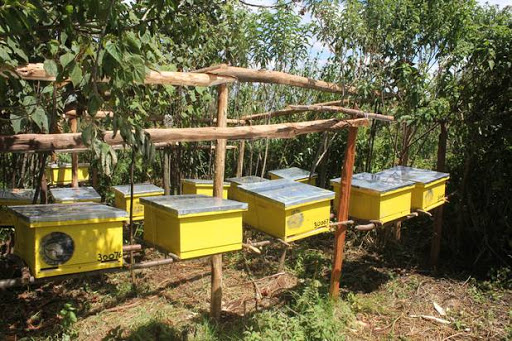

In beekeeping, the place where you keep your beehives is called an Apiary, or a bee yard. Because beekeeping has different practices around the world, there are many different kinds of apiaries. Commercial apiaries are large and contain many hives. While, an urban beekeeper’s apiary will consist of a hive or two in their backyard.
No matter the size of the beekeeping operation, beekeepers must be careful when setting up their apiaries. Some things they must take into account are wind, sun, shade, water, and level ground. Next they must decide how far apart should beehives be placed.
Moving beehives is stressful for bees and difficult for the beekeeper, so it’s important to plan out exactly where you want your hives to be.
Safety
Safety is key when setting up an apiary. It is best to keep your bees away from people and heavy foot traffic. It also helps to face your hives towards a tall barrier, or to keep your hives behind a visual barrier.
Easy Access
Between regular maintenance, hive inspections, and honey harvesting, you’ll be spending a good amount of time working on your hives. Make it easier on yourself by ensuring you have easy access to each hive.
That means that you don’t want your hives too crowded, and you also don’t want them so far apart that you need to walk very far to get to them. You should aim to keep 2 – 3 feet of open space around each hive.
Drift
With many beehives in close proximity, you increase your chances of drift. Drift occurs when bees enter a hive that isn’t their own. While bees are usually able to locate their own hives by scent, sometimes other factors can make this difficult for them. A lack of landmarks to navigate by, or even too much wind are known reasons for drifting behavior.
The problem with drift is that if a bee enters the wrong colony, there’s a good chance it may be killed. There are 2 ways to help reduce the chance of drifting. Painting your beehives different colors helps bees to distinguish which hive is theirs. Another way to prevent drift is to have adequate spacing between your hives. Adequate space between hives helps prevent drift.
Technically, beehives can be placed as close or as far as you want. In other countries mobile bee houses are comprised of rows of beehives stacked right up on eachother. While that may work for that type of commercial beekeeping, placing hives so close may lead to some problems for the average beekeeper.
As I mentioned above, drift is a problem when hives are placed too close to each other. Another issue with hives being too close is that you risk alarm pheromone from one hive disrupting other nearby hives.
For those 2 reasons, it is recommended that you place your hives 2 feet apart. That way, your hives will be close enough to work on without walking too far, but also not too close to encourage drifting.
There are a few more things to consider when deciding on beehive placement.
- Place your beehives on level ground. Bees instinctively build their comb perpendicular to the ground. If the ground is not level you will have uneven comb. Furthermore, uneven ground would make it more likely that your hives tip over.
- Facing your hives south or southeast exposes them to the early morning sun. This will make the bees start to forage earlier.
- Be mindful of how much wind your apiary will receive. This is especially important for rooftop beehives, which could get a lot of wind. Too much wind makes temperature regulation difficult for bees. It can also be dangerous if your hives get blown over.
- Don’t forget that bees need water. Make sure that there is a good water source within 50 feet of your hives.
- Elevate your beehives. Hive stands keep your hives at a comfortable waist level. This makes inspections and honey harvesting much easier on the body. Elevating beehives also adds to the longevity of the hive, as a beehive on the ground is susceptible to wood rot and mold.
 Contact Jaguza Support
Contact Jaguza Support